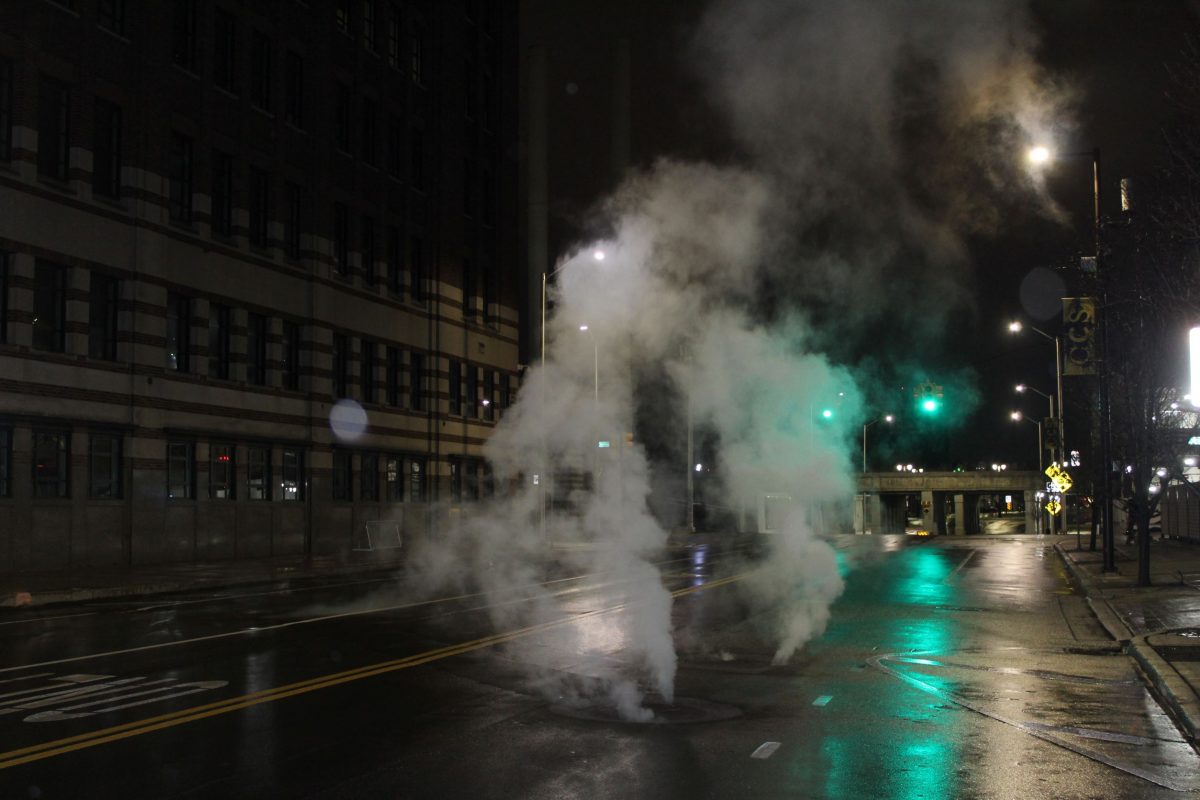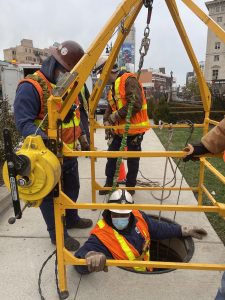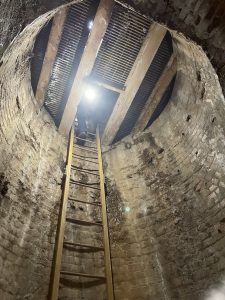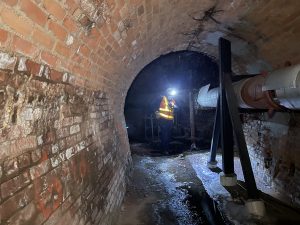CuriosiD: Why does steam come out of Detroit’s streets?
In downtown Detroit and the Cass Corridor, it looks like steam is coming out of the sewers. WDET gets to the bottom (literally) of what’s really going on.

A steam plume rises out of a manhole cover in Detroit's New Center, December 2021.
WDET’s CuriosiD series answers your questions about everything Detroit. Subscribe to CuriosiD on Apple Podcasts, Spotify, NPR.org or wherever you get your podcasts.
In this episode of CuriosiD, we answer the question:
“Why does steam come out of Detroit’s streets?”
The short answer
It looks like there’s steam rising out of Detroit’s sewers downtown, in Midtown and in New Center. While steam is coming out of Detroit manhole covers, it’s not from the sewers. The steam originates from a network of underground tunnels and pipes managed by the company Detroit Thermal. The steam is primarily used for heating in nearby buildings, but it’s also used to sterilize hospital equipment, brew beer, steam hot dogs and more.
Editor’s Note: This story was originally reported in December 2021. Since then, Detroit Thermal was acquired by the French company Vauban Infrastructure Partners.
Climbing down a manhole
I’m looking into a manhole in front of the Gem Theater in downtown Detroit. There’s no steam coming out of it, but officials from the company Detroit Thermal say this is one of a handful of places where they can access their network of steam tunnels.
Detroit Thermal invited me to go down with them to take a look. But there’s no elevator or stairs here. To get to the bottom, I’ll have to climb down a 60-foot ladder. Luckily, the company has brought out a cable system that I can hook on to.

Doug Jablonski, distribution manager with Detroit Thermal, explains this retrieval device will keep me safe in case I fall.
“It’ll grab you and then we’ll lock you tight,” he says.
Before I go down, Jablonski says, “Take your time. There’s no hurry. Some people may get claustrophobic. So, if you feel awkward, odd, scared, there’s nothing wrong with saying, ‘I don’t want to do this.’ We’ll get you out.”
These words are meant to be reassuring, but they make me feel even more nervous. As I contemplate what I’m about to do, a couple of crew members sink into the opening. And then — it’s my turn.
Even though I’m hooked into the safety cable, falling would still be terrifying, so I cautiously tiptoe around the hole. As I peer down, I can’t see the bottom, just the ladder and the first grated landing I’ll be climbing to. I slowly lower myself down and as I do, I’m hit with a blast of wind. Fans are used for airflow and cooling in the tunnel system. As I descend, the wind lets up.
I lower myself rung by rung, passing calcium formations in front of me that give the man-made hole a natural cave-like feel. After a few minutes I finally make it to the bottom.
Detroit Thermal CEO Todd Grzech comes down shortly after. “That wind was a little stronger than I even remember it at the top!” Grzech says.
Inside the steam tunnel
Standing 60 feet below the manhole cover and looking up, it feels like we’re at the bottom of an oversized well. In front of us is a brick-lined tunnel, about 10 feet wide and 10 feet tall at its peak. Grzech says it’s bigger down here than one might expect.

“My understanding is they had miners coming in from all over back in the early 1900s to dig these tunnels out,” he explains.
There are miles of this underground tunnel network, which was built to carry steam to various buildings in the downtown area. Detroit Thermal generates the steam using natural gas. In this tunnel, the steam is transported through a metal pipe, about a foot in diameter. Elsewhere in the network, there aren’t tunnels, but steam pipes are buried underground, carrying vapor to Detroit Thermal’s customers.
Grzech says most of the companies they service use the steam for heating and hot water. A hospital client uses the steam to sterilize equipment. The steam is also used for things like brewing beer at the Detroit Beer Company and steaming hot dogs at Lafayette Coney Island.
The buildings could make their own heat or use their own boiler, but Grzech says it’s more efficient and easier for them to have Detroit Thermal’s steam piped in. “From a safety perspective, they don’t have to worry about maintaining a boiler in their building, they just have a steam line,” he says.
Why we sometimes see steam plumes
As Grzech and I walk down the tunnel, it’s dark. There’s no lighting down here, so flashlights are used to illuminate the way. Grzech shines his on an opening up ahead, pointing out where the pipe bends. It’s a turning point that branches off to feed the Fox Theatre and the Montcalm Fire Department.
On the other side of the pipe, the tunnel opens up like it did at our entry point. About four stories above us, there’s another manhole cover. This one is in the middle of the street and every now and again a car tire runs over it. Grzech and I crane our necks up to look at the manhole cover but something’s missing: There’s no steam.

Grzech says it’s not common to see steam coming out of manholes in this part of their distribution network. “Usually when people see steam discharges from manholes that’s typically the part of our system where we have a buried pipe,” he explains.
Sometimes you’ll see steam when it’s raining or snow is melting. Or sometimes there will be steam because it’s an indication that there’s a leak they need to fix. But even if there’s no water on the ground and all the leaks are taken care of, there will still be some steam plumes.
“As long as you’re moving steam throughout the city, you’re always gonna have some discharge of steam,” Grzech says.
So the next time you see a white plume rising out of a manhole, picture Detroit Thermal’s network of tunnels and buried pipes carrying water vapor around underground Detroit, heating buildings, cooking hot dogs and — at times — simply letting off a little steam.
We want to hear from you!
For an upcoming episode of CuriosiD, tell us your favorite memory from a Coney Island in Metro Detroit. Don’t forget to say the name of the Coney and where it is or was located. Call 313-403-5747 and leave us a voice message or tweet us at @CuriosiDWDET. We might include your comments in a future CuriosiD episode!
Have a general question about Detroit? Ask us here or fill out the form below.
More from CuriosiD:
- Why Does DTW Have Those Giant Fans?
- Are there salt mines under Detroit?
- Why Does Michigan Avenue Have Brick Pavers?
Trusted, accurate, up-to-date.
WDET strives to make our journalism accessible to everyone. As a public media institution, we maintain our journalistic integrity through independent support from readers like you. If you value WDET as your source of news, music and conversation, please make a gift today.

